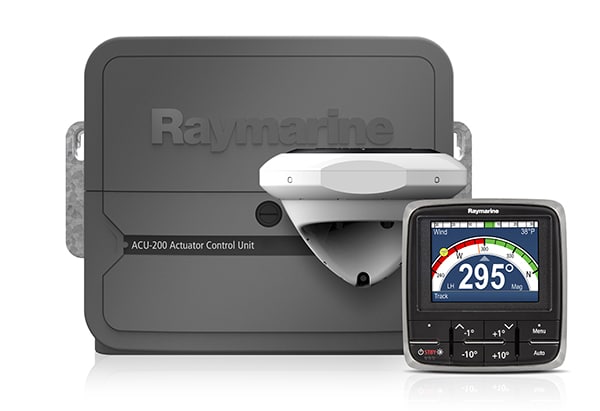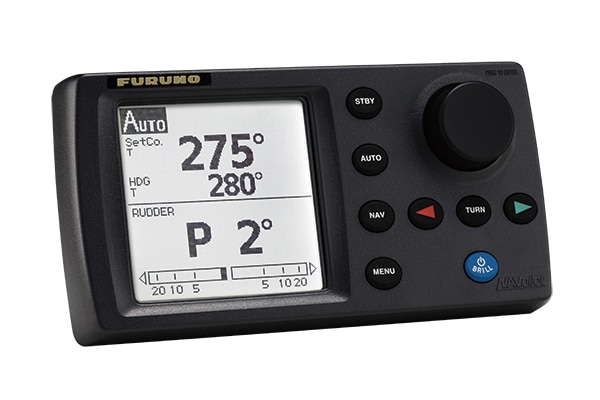Autopilots, useful as they are, have at times enjoyed a reputation as quirky, perhaps the most user-unfriendly electronic component available on fishing boats, even though when correctly set up and calibrated, they did manage to drive the boat. Now things have changed. Currently, all the companies that build them are rapidly wrestling, tweaking and developing the autopilot not only into submission, but also into solid citizens that play well with others. What’s more, the autopilot is emerging as an essential element in navigational and steering systems.

Fresh Start
The newest to hit the market**** is Raymarine’s Evolution autopilot, which completely replaces its previous autopilot line. “The big news on Evolution is our new sensor technology, based around our new EV Sensor core,” says Raymarine’s Jim Hands. The EV Sensor replaces the traditional flux-gate compass that has been at the heart of autopilot technology for decades, and it’s a lot less persnickety. It’s not subject to magnetic fields on the boat or the environment, it can be mounted anywhere, and it has powerful capabilities.
The EV core is a nine-axis heading sensor that monitors boat movement in all directions, essentially a 3-D sensor. It’s driven by a set of sophisticated motion-analysis algorithms, Evolution AI, designed by parent company FLIR’s motion-control engineers. The basic technology is aerospace derived, and it has recently seen a lot of success as the key guidance system in “autonomous vehicles,” which the rest of us know as drones.
In combination, the EV Sensor and Evolution AI gather data on boat motion and sea conditions, and instantly adapt to them to more efficiently steer the boat. The paired technologies also eliminate the need for linearization — the initial calibration runs required to set up a traditional autopilot for the particular boat it is installed in. It’s basically a plug-and-play system, says Hands. “It also eliminates the need for complicated calibration, so an Evolution autopilot can be set up in a just few minutes and does not require a long tweaking and adjustment-laden sea trial. After you install it, just complete a quick dockside setup, and you are ready to go,” he says.
The new pilots, surprisingly, are less expensive that the former generation of pilots, starting at $1,499. An EV-100 hydraulic system, the one most fishing boats would use, is priced about $500 less that the system it replaced, says Hands. Three separate steering modes, Leisure, Cruising and Performance, control how aggressively the autopilot sticks to its course. Leisure, for example allows for 15 to 20 feet of drift off-course before it corrects. This comes down to power-consumption draw and fuel consumption, says Hands.
With the release of Raymarine’s LightHouse version 7 software in July, all MFDs can act as full-function Evolution autopilot control heads, handy when dash space is limited. The optional p70R control head not only provides a backup, but the knob on the head becomes a functional steering wheel.

Simplicity Rules
Moving well into the realm of autopilot as an integral part of steering system, Furuno continues to refine and develop the NavPilot 700. Since its somewhat understated release more than a year ago, the NavPilot platform has seen a steady stream of upgrades in both functions, features and compatibility — and, most welcome, a corresponding overall simplification in hardware and operation.
Most obvious of these is the recent upgrade in software that allows NavNet TZtouch touch-screen control from the MFD, which eliminates the necessity of a separate autopilot control head at the helm. Additionally, Fantum Feedback not only abandons the traditional physical rudder position indicating mechanism, but it also relies on a time-based rudder gain process in favor of an angle-based indicator, effective from trolling speed to more than 60 knots.
Two separate operating modes, Economy and Precision, allow for variable deviation from a set course. “These settings allow the boat to drift,” says Furuno’s Eric Kunz,“which is good in bigger seas.” Economy modes allow course drift of about .1 nautical miles off-course, roughly 60 feet. “This yields a gain in efficiency,” says Kunz. “There is less rudder movement, less wear on the system, and less fuel consumption.” Precision mode, on the other hand, tracks within .1 nm of the set course, about 6 feet. “In Economy mode, we’ve found gains of up to 2 and 3 percent in fuel economy,” says Kunz.
At the core of Furuno’s developing system is the FPS8, an ingenious valve manifold block that provides Safe Helm and Power Assist steering functionality for any vessel with hydraulic steering, and eliminates the need for a separate power-steering system and hydraulic pump.
Traditional power steering relies on an engine-driven hydraulic pump. “The pump sucks energy off the engine, whether you are steering or not,” says Kunz. “On a boat, that translates into a drag of 5 to 10 horsepower. You can extrapolate how much fuel you are using, even when you are not touching the steering wheel.” The whole, integrated NavPilot 700 system, says Kunz, “is really geared toward economy, efficiency and ease of operation.”
The NavPilot 700 has already proved itself on a range of fishing boats as large as 72 feet, as well as center consoles starting at 26 feet with up to four outboard engines. Recently the system was certified for compatibility with both Volvo Penta IPS and Yamaha Helm Master









